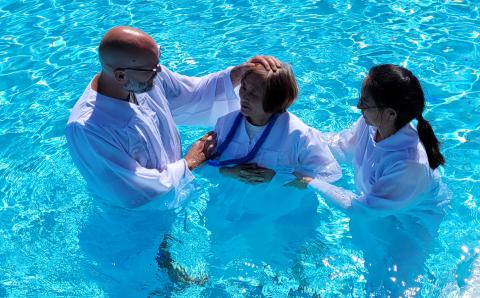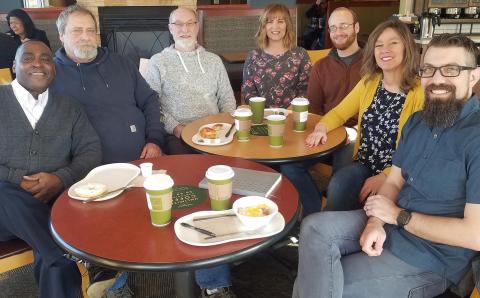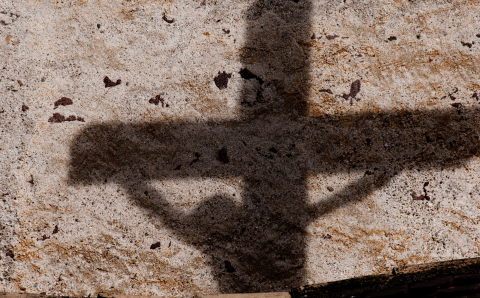The Banner has a subscription to republish articles from Religion News Service. This story by Bob Smietana was published on religionnews.com Feb. 14, 2023. Subheadings have been added
Last Wednesday (Feb. 8), students at Asbury University gathered for their biweekly chapel service in the 1,500-seat Hughes Auditorium.
They sang. They listened to a sermon. They prayed.
Nearly a week later, many of them are still there.
“This has been an extraordinary time for us,” Asbury President Kevin Brown said during a gathering Monday, more than 120 hours into what participants have referred to as a spiritual revival.
The revival has disrupted life and brought national attention to Asbury, an evangelical Christian school in Wilmore, Ky., about a half-hour outside of Lexington. Videos of students singing, weeping, and praying have been posted on social media, leading to both criticism and praise from onlookers. News of the revival has also drawn students and other visitors to the campus to take part in the ongoing prayer and worship.
“We’ve been here in Hughes Auditorium for over a hundred hours—praying, crying, worshiping and uniting—because of Love,” wrote Alexandra Presta, editor of The Asbury Collegian, the school’s student newspaper, who has been chronicling the services on campus. “We’ve even expanded into Estes Chapel across the street at Asbury Theological Seminary and beyond. I can proclaim that Love boldly because God is Love.”
The ongoing meetings in the chapel have brought back memories of earlier revivals in the school’s history. A similar revival in the 1970s is recounted in a 2017 video produced by the university. The gatherings also come at a time when many young Americans have lost faith in organized religion—with a recent study finding that 43% of adults under 30 say they never attend services.
Officials at Asbury did not respond to requests for comment.
Historical precedents
Michael McKenzie, associate professor of religion and philosophy at Keuka College in upstate New York, said revivals have long been a staple in the Methodist tradition that Asbury belongs to. The school is named for Francis Asbury, a circuit-riding preacher who helped Methodism grow from modest beginnings to the largest Christian group in America during the 1800s.
The denomination often grew through revivals—large group meetings that stressed a personal experience of God and a return to the basics of Christianity. One of the most famous revivals in American history took place in Cane Ridge, Ky., about an hour northwest of Asbury, where thousands gathered in 1801.
Methodists in America have fallen on hard times in recent decades, with the largest denomination in the tradition—the United Methodist Church—declining precipitously in membership and facing a schism over LGBTQ inclusion.
McKenzie, who has studied early Methodist revivals, said revivals often happened when people felt things had gone wrong and were trying to recapture something that had been lost.
Online accounts of the meetings at Asbury, he said, seem to “fit all the historical signposts of previous revivals.”
“I think a lot of people sense that America and American Christianity have lost (their) way,” he said. “And they seem to me that they are looking to get back to Jesus in a profound experiential way.”
Like revivals in the past, said McKenzie, the one at Asbury seems to have happened spontaneously. They often bypass leaders and start from the grassroots. That makes them harder to predict or control. They also can be a way of separating spiritual experience from the baggage of organized religion, said McKenzie.
Many U.S. colleges were founded by church groups that hoped revivals would be a regular experience in the lives of students, said Andrea Turpin, associate professor of history at Baylor University. For some students, she said, the revivals were a place to experience religious conversion, while others might have experienced a deepening of their faith at such revivals.
“You would cancel classes, you’d have prayer meetings, and it would sweep through the school about once a year,” said Turpin, who studies religion and higher education.
An 1806 revival at Williams College in Massachusetts, known as the “Haystack Prayer Meeting,” helped launch the modern international missions movement in the United States. At Mount Holyoke College in Massachusetts, founded in the 1800s as a seminary for women, many of the school’s early students went on to work in Christian service, often prompted by revivals, said Turpin.
‘Authentic revivals return the church to what it is supposed to be’
For the Rev. Matt Erickson, pastor of Eastbrook Church in Milwaukee, a five-day campus revival at Wheaton College in the mid-1990s was a life-changing event. Erickson had come to the school in hopes of preparing for the ministry, but that calling had faded during his studies.
He recalled that during a campus missions conference, students began coming forward to ask for prayer and for spiritual renewal. That led first to an all-night prayer service and then to a series of evening meetings that ran late into the night. The last evening of the revival was a commissioning service for people who wanted to go into the ministry. Erickson said that experience led many of his friends into the pastorate or other Christian work.
“There was a sense of the presence of God,” he said, adding that it went beyond simply an emotional experience. He said he hopes what’s happening at Asbury can lead students there into lives of service to God and others.
Erickson said he’s been a bit dismayed at some of the social media criticism of the revival—saying it will take time to see if the gatherings lead to real change in people’s lives.
Author and activist Shane Claiborne is also optimistic. He has been following the meetings and talking to Asbury students from afar and said a revival can lead to action. Claiborne, who has friends on the Asbury campus, pointed to the revivals of Charles Finney in the 1800s. Many of the people who responded to Finnney’s altar calls for salvation also joined the abolitionist movement.
“I believe in social transformation,” Claiborne said. “I also believe in personal and spiritual transformation.”
Howard Snyder, a retired professor of the history and theology of mission at nearby Asbury Theological Seminary, which is separate from the university, said revivals can provide hope in difficult times. They become real if they lead to people living out the values of Jesus’ teaching.
“Authentic revivals return the church to what it is supposed to be,” he said in an email. “The people of God faithfully following Jesus.”
c. 2023 Religion News Service
About the Author
Religion News Service is an independent, nonprofit and award-winning source of global news on religion, spirituality, culture and ethics.








